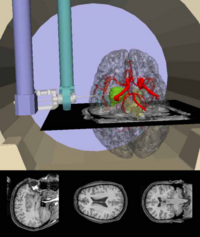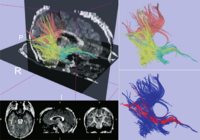Difference between revisions of "Events:HST-563-March2008"
| Line 4: | Line 4: | ||
| − | = | + | |
| + | ==Background:== | ||
[[Image:robot.png|200px]] | [[Image:robot.png|200px]] | ||
[[Image:slicer.png|200px]] | [[Image:slicer.png|200px]] | ||
| − | + | ||
In comparison to other medical imaging modalities, magnetic resonance imaging (MRI) has clear advantages in its volumetric scanning capabilities, tissue discrimination and the detailed delineation of anatomic features. Additionally, MR imaging has unique potential capabilities for functional physiologic imaging and temperature mapping. These features of MR imaging motivated the development of intraoperative MR (IMRI) imaging for guidance of biopsy, thermal ablation and other surgical procedures. The major application of IMRI has been neurosurgical cases, including biopsy, drainage and tumor ablation. Other applications were liver biopsy and sinus endoscopic surgery. | In comparison to other medical imaging modalities, magnetic resonance imaging (MRI) has clear advantages in its volumetric scanning capabilities, tissue discrimination and the detailed delineation of anatomic features. Additionally, MR imaging has unique potential capabilities for functional physiologic imaging and temperature mapping. These features of MR imaging motivated the development of intraoperative MR (IMRI) imaging for guidance of biopsy, thermal ablation and other surgical procedures. The major application of IMRI has been neurosurgical cases, including biopsy, drainage and tumor ablation. Other applications were liver biopsy and sinus endoscopic surgery. | ||
| Line 20: | Line 21: | ||
An example scenario | An example scenario | ||
| − | ===Recommended reading=== | + | ===Recommended reading before the class=== |
| Line 34: | Line 35: | ||
| − | #Background reading: | + | #Background reading: |
| + | |||
| + | |||
| + | #We will review the background of MRI-guided therapy and Image guided therapy in general. | ||
| + | the following slide will be presented. | ||
| + | |||
#Lab demonstration: the 2 hr on-site session at the Surgical Planning Laboratory and Brigham and Women's Hospital. | #Lab demonstration: the 2 hr on-site session at the Surgical Planning Laboratory and Brigham and Women's Hospital. | ||
Revision as of 21:15, 14 March 2008
Home < Events:HST-563-March2008Contents
Lab date/time/location
- March 19, 2008
- [Direction http://www.spl.harvard.edu/pages/Directions]
Background:
In comparison to other medical imaging modalities, magnetic resonance imaging (MRI) has clear advantages in its volumetric scanning capabilities, tissue discrimination and the detailed delineation of anatomic features. Additionally, MR imaging has unique potential capabilities for functional physiologic imaging and temperature mapping. These features of MR imaging motivated the development of intraoperative MR (IMRI) imaging for guidance of biopsy, thermal ablation and other surgical procedures. The major application of IMRI has been neurosurgical cases, including biopsy, drainage and tumor ablation. Other applications were liver biopsy and sinus endoscopic surgery.
There are many benefits in using pre-operatively obtained MRI as part of an analysis of imagery from IMRI. For example, IMRI has some limitations in its imaging capability in comparison to pre-operative MRI from conventional diagnostic MR scanner, since requirements for interventional use (for example, the use of surface coils for good access) have some impact on the imaging capability. After performing a registration that determines the proper spatial relationship between the pre-operative MRI and IMRI, one could compare and determine whether changes in tissue structure have occurred. For instance, this would be extremely useful in evaluating the extent of tumor.
We can further appreciate the benefit of pre-operative image, if we can co-register imagery from other modalities than MRI. Currently, we can register computed tomography (CT), T1- and T2-weighted MRI: magnetic resonance angiography (MRA), single photon emission computed tomography (SPECT). Incorpolatin of these images can provide information that can bot be deduced from regular MRI. In general, utilizing pre- and intra-operative image registration would allow a surgeon to more precisely identify and avoid critical structures and more accurately locate pathological tissues during a procedure.
In this paper, we will report our approach to register pre-operative image to intra-operative MRI and use co-registered images to navigate neurosurgeries. We will first outline the registration method through maximization of mutual information. Then, the comprehensive accuracy study of the registration and clinical application of the method are introduced. In the clinical application section, we will introduce our engineering and computational setup to achieve online and near real-time registration and navigation in an inerventional MRI scanner (Signa SP, General Electric Medical Systems, Milwaukee, WI). An example scenario
Recommended reading before the class
http://www.spl.harvard.edu/pages/Special:PubDB_View?dspaceid=1225
http://www.spl.harvard.edu/pages/Special:PubDB_View?dspaceid=294
http://www.spl.harvard.edu/pages/Special:PubDB_View?dspaceid=1244
http://www.spl.harvard.edu/pages/Special:PubDB_View?dspaceid=1247
Overview/goals of lab exercise
- Background reading:
- We will review the background of MRI-guided therapy and Image guided therapy in general.
the following slide will be presented.
- Lab demonstration: the 2 hr on-site session at the Surgical Planning Laboratory and Brigham and Women's Hospital.
Computer assisted
- A small number of questions to answer about the lab demonstration and background reading to test comprehension.
Lab write-up expectations
a five page report with answers to the pre-lab homework and lab exercises.
Pre-lab Exercises
Tutorial
We will take series of tutorials available at http://wiki.na-mic.org/Wiki/index.php/Slicer:Workshops:User_Training_101
Topics we cover will be
- Data Loading and Visualization
- Data Saving
- Manual Segmentation
- Level-Set Segmentation
- Automatic Brain Segmentation
- Registration
- Diffusion Tensor Imaging Analysis
- Nrrd File Format
- Dicom to Nrrd Conversion
- Functional Magnetic Resonace Imaging Analysis
Homework problems
Please read either one of the following literature before the class.
Lab Exercises
The lab exercise should be thought of as the take-home portion of the lab which forms the bulk of the lab-writeup (the finished document that gets graded). It should include some sort of data processing, perhaps including a walk-through/example of the image processing technique, code writing (preferable in matlab or other widely-known software package), and questions to probe understanding of the material. I’m sure this section will vary the most from lab to lab, but it should at least include a series of questions that can be answered (and graded!).
Description of data/process
This section should link the student to the data (e.g. found in course locker) and have simple instructions about what to do with the data (e.g. FFT the data series). Questions can be interspersed.
Questions
Questions can be actual problems (e.g. remove the shot noise from image A) or more open-ended discussion questions (e.g. what are the advantages/disadvantages of signal averaging?)

